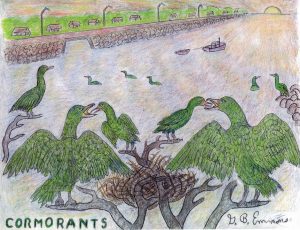The cormorant is classified as a sea bird along with the albatross, penguin, and tern. Each one today is a specialized living proof of Darwin’s theory of adaption of species to environment in waters all around the world. The cormorant, for example, is able to drink salt water and fly under water with elliptical wings and streamlined body with waterproof feathers and propelled by webbed feet.
Their population has increased dramatically since the use of DDT and other toxic chemicals was banned in 1970. Darwin, in research of the Galapagos Islands, was astonished to find the Pacific cormorant to be as flightless as the penguin. To this very day, in Japan they are trained to dive and retrieve their catch of fish for human consumption with gizzards tied and unable to swallow.
Buzzards Bay is a summer haven for the migratory cormorant with many miles of coastline and causeways, as my drawing connecting Sconticut Neck to West Island in Fairhaven demonstrates (viewable online). Boaters coming into port see them as sentinels standing on channel markers, guarding the mouths of harbors while loafing in the sunlight to dry and lubricate feathers from a gland above their tails, able to turn their necks practically 360 degrees.
Their nests are often elevated platforms in a tree near the water’s edge where both parents incubate and feed the young with bits of fish regurgitated into their mouths. As incubation of each egg begins as soon as laid, hatching is spaced out creating a growing size difference. Due to nourishment competition, often as few as two chicks grow to maturity, Darwin’s “survival of the fittest” at an early age.
Cormorants, like many other sea birds, congregate in large colonies at the same site for generations. Their gathering presence is rather invasive and discourages nesting of other birds. Their predation also interrupts reproduction, schooling, and spawning of alewife gizzard shad and yellow perch. Even more serious, cormorants are prone to carry a viral Newcastle disease. After protected by the Migratory Bird Act of 1918, an increasing necessity for population regulation control was approved as legal in 1999 to be federally activated by permit if applied by 24 eligible states, as well as recognized Native American tribes.
Our nearest living freshwater cousin to the cormorant locally is the common loon, although it migrates in winter to the ocean and turns a salty color. It is one of our oldest surviving creatures.
From Darwin’s Origin Of Species, my conclusion is that access to underwater habitat food supply enabled their survival, even during planetary periods of terrestrial extinction. Now, my article and drawing of the cormorant is on literary record joining my other subjects such as the mountain lion, fisher, rattlesnake, turkey buzzard, and spider. Each was inspired by my educated Native American belief that every living thing on Earth is sacred, even the smallest blade of grass.
By George B. Emmons
